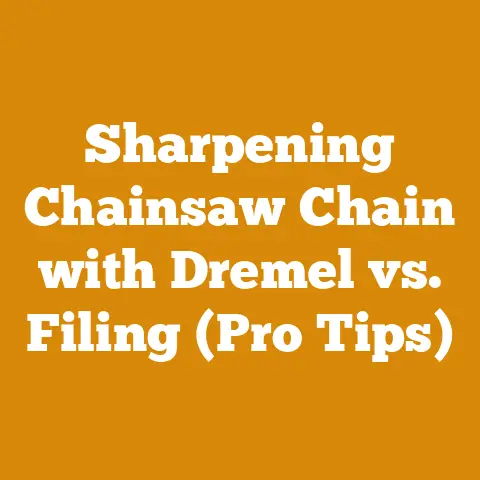What Are the Top 5 Hardest Woods? (5 Janka Facts Inside)
The Unyielding Five: Exploring the World’s Hardest Woods and Their Impact on Your Budget
Craftsmanship, in its purest form, is a dance between the artisan and the material.
And when that material is wood, the dance becomes a battle of wills, especially when you’re dealing with the titans of the forest – the hardest woods on Earth.
But, beyond the sheer challenge of working with these dense beauties, lies a complex web of costs that can significantly impact your woodworking projects or firewood preparation endeavors.
As someone who’s spent years wrestling with logs and coaxing them into submission, I understand the importance of knowing not just what you’re working with, but how much it’s going to cost you.
In this article, we’ll delve into the top 5 hardest woods, explore their unique properties (including those all-important Janka hardness facts), and then, crucially, break down the costs associated with acquiring, processing, and utilizing them.
Get ready to sharpen your knowledge – and your tools!
What Makes a Wood “Hard”? The Janka Hardness Test
Before we dive into the specific woods, let’s understand how we measure hardness.
The Janka hardness test is the industry standard.
It measures the force required to embed a .444-inch steel ball halfway into a piece of wood.
The higher the number, the harder the wood.
While hardness isn’t the only factor determining workability (grain, density, and stability also play crucial roles), it’s a reliable indicator of resistance to wear and tear, and the effort required to shape and cut it.
The Top 5 Hardest Woods: Janka Facts & Initial Cost Considerations
Here they are, the heavy hitters of the wood world.
Keep in mind that prices fluctuate wildly based on availability, location, and grade.
These are estimated ranges to give you a starting point.
Australian Buloke (Janka: 5,060 lbf): This ironwood from Down Under is a true behemoth.
Its extreme density makes it incredibly durable, but also notoriously difficult to work with.- Initial Cost Consideration: Expect to pay a premium.
Due to its limited availability outside Australia and the sheer difficulty of harvesting and processing, Australian Buloke can command prices of $50-$100+ per board foot, if you can find it. -
Quebracho (Janka: 4,570 lbf): This South American hardwood is known for its reddish hue and exceptional density.
The name “Quebracho” literally translates to “axe-breaker,” a testament to its toughness. -
Initial Cost Consideration: Slightly more accessible than Buloke, Quebracho can still be pricey, ranging from $30-$70 per board foot.
Availability varies depending on your location and import regulations. -
Lignum Vitae (Janka: 4,500 lbf): Historically prized for its self-lubricating properties, Lignum Vitae was the go-to material for bearings and ship propeller shaft bushings.
It’s incredibly dense and oily. -
Initial Cost Consideration: Lignum Vitae is endangered in many regions, and its trade is often restricted.
If you can find legally sourced material, expect to pay a significant premium – upwards of $80-$150+ per board foot.
Its scarcity and unique properties drive the price up. -
Pau Lope (Janka: 3,540 lbf): Also known as Brazilian Ironwood or Ipe, Pau Lope is a popular choice for decking and flooring due to its durability and resistance to rot and insects.
-
Initial Cost Consideration: Pau Lope is more readily available than the previous three, making it a slightly more budget-friendly option.
Expect to pay between $15-$40 per board foot, depending on the grade and supplier. -
Snakewood (Janka: 3,840 lbf): Famous for its unique, snake-like patterns, Snakewood is a highly sought-after exotic wood used for small, decorative items like knife handles, walking sticks, and musical instrument parts.
-
Initial Cost Consideration: Snakewood is expensive due to its rarity and the difficulty of finding pieces with desirable patterns.
Expect to pay $50-$150+ per board foot for high-quality Snakewood.
- Initial Cost Consideration: Expect to pay a premium.
The Hidden Costs: A Deep Dive into the Price of Hardness
The initial cost of the wood is just the tip of the iceberg.
To truly understand the financial commitment, we need to consider the entire process, from acquisition to finished product.
1. Acquisition Costs: Timber Purchase vs. Harvesting
The way you acquire the wood significantly impacts the cost.
- Timber Purchase: Buying lumber from a supplier is the most straightforward option, but also potentially the most expensive, especially for exotic hardwoods.
Prices are influenced by:- Grade: Higher grades (e.g., FAS – First and Seconds) with fewer knots and blemishes command higher prices.
- Thickness: Thicker boards are generally more expensive.
- Supplier Location: Proximity to the source and transportation costs play a major role.
- Market Fluctuations: Timber prices are subject to global market forces and can vary significantly.
I’ve seen prices for Ipe fluctuate by as much as 30% in a single year due to changes in import tariffs and demand.
- Harvesting Your Own: This option can be cheaper in the long run, but requires significant investment in time, equipment, and permits.
- Permits and Regulations: Many areas require permits for felling trees, even on private property.
These permits can cost anywhere from $50 to several hundred dollars, depending on the location and the size of the harvest. - Land Access: If you don’t own forested land, you’ll need to negotiate access with a landowner.
This could involve paying for timber rights or entering into a profit-sharing agreement. - Transportation: Getting the logs from the forest to your workshop or firewood processing area requires specialized equipment, such as a tractor, skidder, or logging truck.
Rental fees for this equipment can range from $100 to $500+ per day.
- Permits and Regulations: Many areas require permits for felling trees, even on private property.
Data Point: According to the USDA Forest Service, the average stumpage price (the price paid to a landowner for standing timber) for hardwood sawtimber in the United States in 2022 was around $200 per thousand board feet.
However, this figure varies dramatically by species and region.
2. Tool Costs: Chainsaws, Blades, and Beyond
Working with extremely hard woods puts a significant strain on your tools.
- Chainsaws: You’ll need a powerful chainsaw with a sharp, high-quality chain.
- Initial Investment: A professional-grade chainsaw capable of handling hardwoods can cost between $800 and $1500+.
- Maintenance: Chainsaws require regular maintenance, including sharpening, cleaning, and replacing worn parts.
A chainsaw chain can cost $30-$60+, and you’ll likely need to replace it more frequently when working with hard woods.
I personally find myself sharpening my chains at least twice as often when working with Ipe compared to softer woods like pine. - Sharpening Equipment: Investing in a good-quality chainsaw sharpener (manual or electric) is essential.
Prices range from $50 to $300+.
- Saw Blades (for Milling or Resawing):
- Band Saw Blades: When milling logs into lumber, you’ll need a band saw with a blade specifically designed for hardwoods.
These blades are typically made of high-speed steel or carbide and can cost $50-$150+ per blade. - Circular Saw Blades: For smaller projects, you might use a circular saw.
Invest in carbide-tipped blades designed for cutting hardwoods.
Expect to pay $30-$80+ per blade.
- Band Saw Blades: When milling logs into lumber, you’ll need a band saw with a blade specifically designed for hardwoods.
- Hand Tools: Hardwoods can be tough on hand tools as well.
- Planes, Chisels, and Saws: High-quality hand tools made from hardened steel are essential for shaping and finishing hardwoods.
Expect to pay a premium for these tools, but they’ll last a lifetime with proper care.
- Planes, Chisels, and Saws: High-quality hand tools made from hardened steel are essential for shaping and finishing hardwoods.
Personal Story: I once tried to mill a Quebracho log with a standard chainsaw chain.
After just a few cuts, the chain was completely dull and practically useless.
I learned the hard way that investing in the right tools is crucial when dealing with these tough woods.
3. Labor Costs: The Value of Expertise
If you’re not handling the entire process yourself, labor costs can be a significant factor.
- Logging Crew: Hiring a professional logging crew to harvest timber can cost anywhere from $500 to $2000+ per day, depending on the size of the crew, the complexity of the job, and the location.
- Firewood Handlers: If you’re processing firewood, you might hire laborers to help with cutting, splitting, and stacking.
Wages typically range from $15 to $30+ per hour, depending on experience and location. - Woodworkers/Craftsmen: If you’re commissioning a custom woodworking project using hardwood, the labor costs will depend on the complexity of the design and the skill of the craftsman.
Hourly rates for skilled woodworkers can range from $50 to $150+.
Data Point: According to the Bureau of Labor Statistics, the median hourly wage for logging workers in the United States in May 2022 was $20.79.
However, wages vary significantly by region and experience level.
4. Drying Costs: Patience Pays Off (Literally)
Hardwoods are typically denser and have a higher moisture content than softwoods, which means they take longer to dry.
Proper drying is crucial to prevent warping, cracking, and other defects.
- Air Drying: This is the most cost-effective method, but it can take months or even years for hardwoods to dry properly.
- Space Requirements: You’ll need a well-ventilated space to stack the lumber.
- Time Investment: Regular monitoring and adjustments to the stack are necessary to ensure even drying.
- Kiln Drying: This method is faster and more controlled, but it comes at a cost.
- Kiln Rental: Renting a kiln can cost anywhere from $50 to $200+ per day, depending on the size and type of kiln.
- Energy Costs: Kilns consume a significant amount of energy, which can add to the overall cost.
Calculation: The drying time for wood is influenced by several factors, including the initial moisture content, the species of wood, the temperature, and the relative humidity.
A general rule of thumb is that air-drying hardwoods takes about one year per inch of thickness.
Kiln drying can reduce this time to a few weeks or even days, but at a significantly higher cost.
Formula: A simplified estimate of drying time (in days) can be calculated as: Drying Time = K * Thickness (inches) * Moisture Content Difference (%), where K is a constant that varies depending on the drying method and species.
5. Finishing Costs: Protecting Your Investment
Applying a finish to your hardwood project is essential to protect it from moisture, scratches, and UV damage.
- Types of Finishes:
- Oils: Oils like linseed oil and tung oil are relatively inexpensive and easy to apply, but they offer limited protection.
- Varnishes: Varnishes provide a more durable finish and are resistant to water and chemicals.
Prices range from $20 to $50+ per quart. - Lacquers: Lacquers provide a hard, durable finish and dry quickly, but they require specialized equipment and ventilation.
- Polyurethanes: Polyurethanes are highly durable and water-resistant, making them a good choice for high-traffic areas.
Prices range from $25 to $60+ per quart.
- Application Costs: You’ll need brushes, rollers, sandpaper, and other supplies to apply the finish.
These costs can add up, especially for larger projects.
Data Point: According to HomeAdvisor, the average cost to refinish wood furniture in the United States in 2023 ranges from $200 to $1,000, depending on the size and complexity of the piece.
This figure includes both materials and labor costs.
6. Transportation Costs: From Forest to Project
Don’t underestimate the cost of moving these heavy materials.
- Fuel Costs: Hauling logs or lumber requires a truck or trailer, and fuel costs can be significant, especially with rising gas prices.
I always factor in at least 10% of the material cost for transportation. - Rental Fees: Renting a truck or trailer can cost $50-$100+ per day.
- Shipping Costs: If you’re ordering lumber from a supplier, shipping costs can be a substantial expense, especially for large or heavy items.
7. Waste Disposal Costs: Reduce, Reuse, Recycle
Even with careful planning, there will inevitably be some waste material.
- Disposal Fees: Landfill fees can range from $50 to $100+ per ton.
- Recycling Options: Consider recycling wood scraps or using them for other projects.
- Firewood: Smaller scraps can be used as firewood (if the wood is suitable and legal to burn in your area).
Budgeting for Hardwoods: A Practical Approach
Now that we’ve broken down the cost components, let’s look at how to create a realistic budget.
- Define Your Project Scope: Clearly define the size and complexity of your project.
This will help you estimate the amount of lumber you’ll need and the labor hours involved. - Research Lumber Prices: Get quotes from multiple suppliers for the specific hardwood you’re considering.
Be sure to factor in shipping costs. - Estimate Tool and Supply Costs: Make a list of all the tools and supplies you’ll need, including chainsaws, blades, sandpaper, and finishing materials.
- Calculate Labor Costs: If you’re hiring laborers or craftsmen, get quotes for their services.
- Factor in Drying Costs: Estimate the drying time based on the species of wood and the drying method you’ll be using.
- Add a Contingency: Always add a contingency of 10-15% to your budget to cover unexpected expenses.
Case Study: I recently completed a custom dining table project using Pau Lope.
My initial budget was $1,500, but the final cost ended up being closer to $2,000.
The extra expenses included unexpected tool repairs, higher-than-anticipated shipping costs, and additional finishing materials.
The contingency fund saved the day.
Cost Optimization Strategies: Saving Money Without Sacrificing Quality
Here are some practical tips for reducing the cost of working with hardwoods:
- Source Lumber Locally: Buying lumber from local sawmills or suppliers can save you money on transportation costs.
- Consider Lower Grades: If the project allows, consider using lower grades of lumber with more knots and blemishes.
You can often work around these imperfections or incorporate them into the design. - Buy in Bulk: Buying lumber in bulk can often result in significant discounts.
- Dry Your Own Lumber: Air-drying lumber is a cost-effective alternative to kiln drying, but it requires patience and planning.
- Sharpen Your Tools Regularly: Sharp tools are more efficient and require less effort to use, which can save you time and money.
- Minimize Waste: Plan your cuts carefully to minimize waste material.
- Negotiate Prices: Don’t be afraid to negotiate prices with suppliers and laborers.
- Consider Alternative Species: If the cost of your preferred hardwood is too high, consider using a less expensive alternative that offers similar properties.
- Rent Tools: For infrequent projects, renting specialized tools can be more cost-effective than buying them.
The Firewood Angle: Hardwood as Fuel
If you’re considering using these hardwoods for firewood, the cost equation changes slightly.
While the BTU output of hardwoods is generally higher than softwoods, the increased difficulty of cutting and splitting can impact your overall cost per BTU.
- Splitting Difficulty: The density of these hardwoods makes them incredibly difficult to split, even with a hydraulic splitter.
You might need a more powerful splitter or spend significantly more time and effort. - Drying Time: Hardwoods require a longer drying time to reach optimal moisture content for burning.
This means you’ll need to store the wood for a longer period before you can use it. - Creosote Buildup: Some hardwoods, particularly those with high resin content, can contribute to creosote buildup in your chimney.
Regular chimney cleaning is essential to prevent fire hazards.
Data Point: According to the Energy Information Administration (EIA), the average price of firewood in the United States in 2023 ranges from $200 to $400+ per cord, depending on the species of wood and the location.
However, this price can vary significantly depending on local market conditions.
Formula: To calculate the cost per BTU of firewood, you’ll need to know the price per cord and the BTU content of the wood.
The formula is: Cost per BTU = Price per Cord / (BTU per Cord).
If you’re sourcing hardwoods from international markets, be aware of the following factors:
- Import Tariffs: Import tariffs can significantly increase the cost of lumber.
- Exchange Rates: Fluctuations in exchange rates can impact the price of imported lumber.
- Sustainability Certifications: Look for lumber that is certified by organizations like the Forest Stewardship Council (FSC) to ensure that it is harvested sustainably.
- Phytosanitary Regulations: Some countries have strict phytosanitary regulations to prevent the spread of pests and diseases.
Be sure to comply with these regulations when importing lumber.
Actionable Takeaways and Next Steps
Working with the world’s hardest woods can be a rewarding experience, but it’s essential to be aware of the costs involved.
By carefully planning your project, researching lumber prices, and implementing cost optimization strategies, you can achieve your woodworking goals without breaking the bank.
Here are some actionable takeaways:
- Research, Research, Research: Before starting any project, thoroughly research the properties and costs of the hardwood you’re considering.
- Create a Detailed Budget: Develop a detailed budget that includes all cost components, from lumber purchase to finishing materials.
- Source Lumber Wisely: Explore different sourcing options to find the best prices.
- Invest in Quality Tools: Invest in high-quality tools that are designed for working with hardwoods.
- Be Patient and Persistent: Working with hardwoods requires patience and persistence.
Don’t be afraid to experiment and learn from your mistakes.
The next step is to start planning your project and gathering quotes from suppliers.
With careful planning and a little bit of elbow grease, you can create beautiful and durable pieces that will last a lifetime.
Remember, the challenge is part of the reward.
Now, go forth and conquer those unyielding five!






